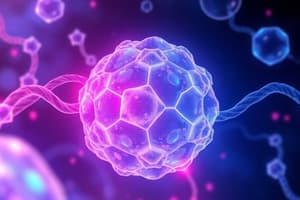Podcast
Questions and Answers
Which of the following statements about proteins is true?
Which of the following statements about proteins is true?
- Proteins have only one level of structure.
- Proteins perform enzymatic catalysis and provide structural support. (correct)
- Proteins are a type of carbohydrate.
- Proteins are composed of nucleotides.
What role do nucleic acids play in cellular function?
What role do nucleic acids play in cellular function?
- They catalyze biochemical reactions.
- Energy storage in the form of glycogen.
- They are involved in genetic information storage and protein synthesis. (correct)
- They serve as structural components of the cell membrane.
Which of the following best describes catabolism?
Which of the following best describes catabolism?
- The transport of substances across cell membranes.
- The breakdown of molecules to release energy. (correct)
- A process that enhances cellular signaling.
- The synthesis of complex molecules from simpler ones requiring energy.
How do enzymes regulate biochemical reactions?
How do enzymes regulate biochemical reactions?
Which statement accurately represents the function of carbohydrates?
Which statement accurately represents the function of carbohydrates?
Which of the following best describes the process of photosynthesis?
Which of the following best describes the process of photosynthesis?
What is the primary purpose of the Polymerase Chain Reaction (PCR) in biochemistry?
What is the primary purpose of the Polymerase Chain Reaction (PCR) in biochemistry?
Which factors can affect enzyme activity?
Which factors can affect enzyme activity?
Flashcards are hidden until you start studying
Study Notes
Key Concepts in Biochemistry
-
Definition: Biochemistry is the study of the chemical processes and substances that occur within living organisms.
-
Major Biomolecules:
- Proteins:
- Composed of amino acids.
- Functions: Enzymatic catalysis, structural support, transport, signaling.
- Levels of structure: Primary, secondary, tertiary, quaternary.
- Carbohydrates:
- Composed of monosaccharides.
- Functions: Energy storage (e.g., glycogen), structural components (e.g., cellulose).
- Types: Simple sugars (monosaccharides, disaccharides) and complex carbohydrates (polysaccharides).
- Lipids:
- Composed of fatty acids and glycerol.
- Functions: Energy storage, membrane structure, signaling molecules (e.g., hormones).
- Types: Fats, oils, phospholipids, steroids.
- Nucleic Acids:
- DNA and RNA, composed of nucleotides.
- Functions: Genetic information storage (DNA) and protein synthesis (RNA).
- Proteins:
-
Metabolism:
- Catabolism: Breakdown of molecules to release energy (e.g., glycolysis, Krebs cycle).
- Anabolism: Synthesis of complex molecules from simpler ones, requiring energy (e.g., protein synthesis, gluconeogenesis).
-
Enzymes:
- Biological catalysts that speed up chemical reactions.
- Characteristics: Specificity, efficiency, regulation.
- Factors affecting enzyme activity: Temperature, pH, substrate concentration, enzyme concentration, inhibitors.
-
Cell Signaling:
- Mechanisms by which cells communicate with each other.
- Involves signaling molecules (ligands) and receptors.
- Types: Hormonal signaling, neurotransmission, autocrine and paracrine signaling.
-
Genetic Biochemistry:
- DNA replication, transcription (DNA to RNA), and translation (RNA to protein) processes.
- Role of enzymes like DNA polymerase, RNA polymerase, and ribosomes.
-
Techniques in Biochemistry:
- Chromatography: Separation of biomolecules.
- Electrophoresis: Separation based on size and charge.
- Spectroscopy: Analyzing molecular composition.
- PCR (Polymerase Chain Reaction): Amplifying DNA.
-
Applications:
- Medicine: Drug development, understanding diseases at a molecular level.
- Biotechnology: Genetic engineering, production of biofuels, and pharmaceuticals.
- Nutrition: Understanding metabolic pathways for dietary impacts.
-
Key Processes:
- Cellular respiration: Conversion of biochemical energy from nutrients to ATP.
- Photosynthesis: Conversion of light energy into chemical energy in plants.
This concise summary captures the fundamental aspects of biochemistry, providing a foundational understanding of the subject.
Definition of Biochemistry
- Study of chemical processes and substances in living organisms.
Major Biomolecules
-
Proteins:
- Composed of amino acids.
- Functions include enzymatic catalysis, structural support, transport, and signaling.
- Levels of structure: primary, secondary, tertiary, quaternary.
-
Carbohydrates:
- Composed of monosaccharides.
- Functions include energy storage (e.g., glycogen) and structural components (e.g., cellulose).
- Types include simple sugars (monosaccharides, disaccharides) and complex carbohydrates (polysaccharides).
-
Lipids:
- Composed of fatty acids and glycerol.
- Functions include energy storage, membrane structure, and signaling (e.g., hormones).
- Types include fats, oils, phospholipids, and steroids.
-
Nucleic Acids:
- DNA and RNA, composed of nucleotides.
- Functions include genetic information storage (DNA) and protein synthesis (RNA).
Metabolism
-
Catabolism:
- Breaks down molecules to release energy (e.g., glycolysis, Krebs cycle).
-
Anabolism:
- Synthesizes complex molecules from simpler ones, requiring energy (e.g., protein synthesis, gluconeogenesis).
Enzymes
- Biological catalysts that accelerate chemical reactions.
- Key characteristics include specificity, efficiency, and regulation.
- Enzyme activity is affected by temperature, pH, substrate concentration, enzyme concentration, and inhibitors.
Cell Signaling
- Mechanisms for cellular communication involving signaling molecules (ligands) and receptors.
- Types include hormonal signaling, neurotransmission, autocrine signaling, and paracrine signaling.
Genetic Biochemistry
- Involves DNA replication, transcription (DNA to RNA), and translation (RNA to protein).
- Key enzymes include DNA polymerase (for replication), RNA polymerase (for transcription), and ribosomes (for translation).
Techniques in Biochemistry
- Chromatography: Separates biomolecules based on differential distribution between phases.
- Electrophoresis: Separates biomolecules by size and charge.
- Spectroscopy: Analyzes molecular composition.
- PCR (Polymerase Chain Reaction): Amplifies DNA for various applications.
Applications of Biochemistry
- Medicine: Drug development and understanding diseases at a molecular level.
- Biotechnology: Genetic engineering, biofuel production, and pharmaceuticals.
- Nutrition: Insights into metabolic pathways and their dietary impacts.
Key Processes
- Cellular Respiration: Converts biochemical energy from nutrients into ATP.
- Photosynthesis: Converts light energy into chemical energy in plants.
Studying That Suits You
Use AI to generate personalized quizzes and flashcards to suit your learning preferences.




